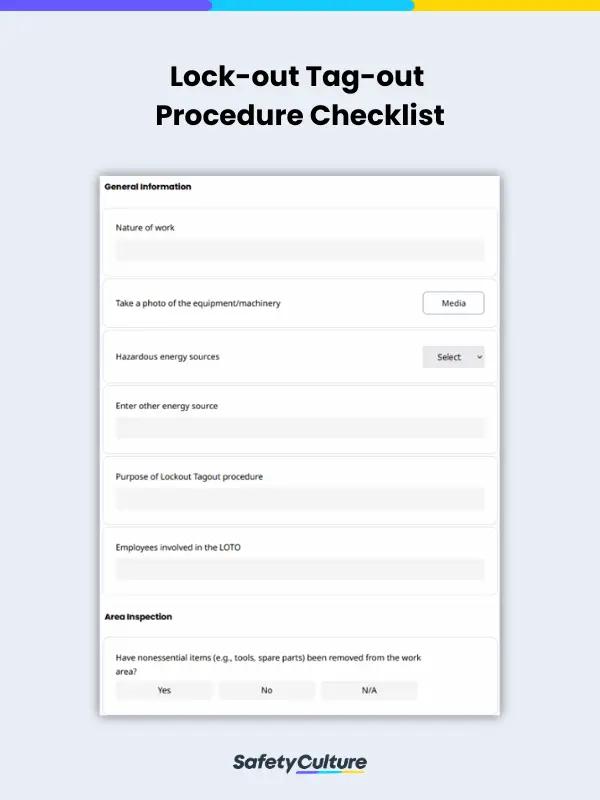What is a Lockout Tagout Procedure Checklist?
A lockout tagout procedure checklist, also called a LOTO checklist, is used by safety officers and managers to ensure that proper steps are taken to isolate energy sources when servicing industrial equipment or heavy machinery. This is done to protect workers against hazards such as accidental energization of equipment or exposure to hazardous energy.
Millions of machine operators and workers are exposed to risks each day due to non-isolated energy sources; lockout tagout procedure checklists aim to protect workers from those risks.
What Should be Included in a LOTO Procedure Checklist?
Lockout tagout procedures can vary depending on the industry or type of machine or equipment. Following OSHA lockout tagout procedure standards by using a procedures template and safety checklist will help ensure that all dangerous machinery and equipment are properly shut off, locked out, and tagged before performing maintenance checks. OSHA estimates that complying with LOTO standards helps prevent 120 fatalities and 50,000 injuries each year. Here are the main sections of a lockout tagout procedure checklist:
Machine/equipment information
- Identify the machine or equipment that will be shut down and record the purpose of the lockout/tagout such as maintenance or repair.
- Identify the energy sources that could cause harm if not isolated such as electrical, mechanical, hydraulic, pneumatic, chemical, thermal, etc.
Area inspection
- Check if the area surrounding the equipment has no items that could pose a risk to the workers during equipment maintenance.
- Employees who are not going to work on the maintenance should also clear the area.
Employees
- Employees are made aware of their responsibilities during the LOTO and maintenance of the machine.
- Employees should be informed that a machine or equipment is about to be serviced and that a lockout tagout procedure is being performed.
LOTO devices
- Ensure that the proper LOTO devices are available for the job.
- The responsible persons who will apply the devices should be identified.
Applying LOTO devices
- Primary and possible secondary sources of energy should be identified and de-energized.
- Ensure that all sources of power are isolated before the proper LOTO devices are applied to each energy-isolating device.
- Lockout the machine or equipment, ensure that shut off is verified and that employees know that it is out of service at the moment.
Removing LOTO devices
- Clear all the tools and place back machine guarding.
- LOTO devices are to be removed by the person who applied them.
- Restore energy to the machine or equipment.
- Inform all the affected employees that the machine or equipment is back in operation.
Periodic LOTO Inspections
A LOTO inspection can only be conducted by a safety supervisor or authorized employee who is NOT involved in the lock out tag out procedure being inspected. To conduct a LOTO inspection, the safety supervisor or authorized employee must do the following:
- Identify the equipment or isolation point that the LOTO procedure is for
- Specify the date of and the employees included in the LOTO inspection
- Identify and correct the deviations and inadequacies of the LOTO procedure
- Review the responsibilities of authorized and affected employees for lockout, tagout, and training
- Verify that you have conducted the LOTO inspection by adding your name and signature
LOTO inspections must be conducted at least annually or more often if necessary.
FAQs about Lockout Tagout Procedure Checklist
The purpose of a lockout/tagout checklist is to ensure that:
- Electrical and mechanical functions are de-energized and disengaged;
- Locking and tagging procedures are being complied with;
- Employees are provided individual safety locks and keys;
- All hazards present during the procedure have been managed adequately;
- All necessary details are reported and documented.
Employers are responsible for creating and maintaining the Lockout/Tagout procedure checklist. They must ensure that it is accurate, up-to-date, easily accessible to employees, and reviewed regularly. Involving relevant personnel, such as maintenance staff, safety officers, and supervisors, is essential for developing comprehensive and effective checklists.


